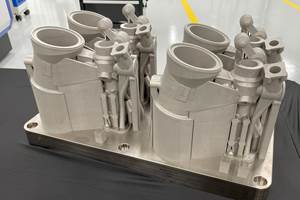Dyndrite, UPM Work to Bring Data Intelligence to Metal 3D Printing Build Plates
The collaboration aims to reduce print failures and enable reliable supply chain for additive manufacturing production.
Dyndrite showcases parametrically created ASTM qualification build plates for major LPBF platforms. It provides materials and process development scientists and engineers with toolpath control. Photo Credit: Dyndrite
Dyndrite and United Performance Metals (UPM) Additive Solutions are collaborating to bring intelligence to critical, yet often ignored 3D printing components. The companies will work together to capture and provide the data that unlocks the variables to build plate life, and bring supply chain predictability and reliability to new and resurfaced build plates.
Dyndrite is a provider of the core Accelerated Computation Engine (ACE) and Application Development Kit (ADK) which is used to create digital manufacturing hardware and software. UPM Additive Solutions is a supplier of metal build plates for the additive industry. The companies are bringing together their expertise to create “smart” metal build plates for the 3D metal printing industry.
The partners say the build plate is an integral component in metal 3D printing because it lays the foundation for every part being built. Unfortunately, most users in the space do not record key data that can unlock the unknowns concerning the life cycle and history of their build plates. Without this information, for example, laser powder bed fusion (LPBF) users face an increased risk of powder leveling issues, internal fatigue and plate warpage that can lead to lost time and costly build failures.
“UPM is excited to partner with Dyndrite and its metal users to unlock the keys to build plate life,” says Chris Prue, applications development manager at UPM Additive Solutions. “Through data, we can put knowledge in the hands of the user to raise throughput and reduce failures. Build plate usage data helps customers understand and manage their usage, and demand for plates to keep costs low while keeping inventory available to reduce downtime. Through smart build plates and a reliable supply chain, we can collectively mature and grow the industry.”
The partners say the AM industry must develop new tools to enable the industry to scale. “ By working with UPM and leveraging the power of machine data we can accelerate learning, improve predictability and grow,” says Harshil Goel, Dyndrite founder and CEO. “Through insights of the data, we allow users to make less risky decisions on their build plates to assure success.”
UPM currently offers subscription-based services to track build plates from initial manufacture to customer and through its refurbishment. Each plate is serialized and maintains accessible quality inspection data. Smart Build Plate customers can view build data associated with each plate from the machine (preheat, laser power, powder melted, heat treatment, stress relief) along with other conditions to which the build plate will be exposed. The UPM Smart Build Plate service will support all major metal 3D printer OEMs, including Aconity, EOS, Renishaw and SLM Solutions, and is expected to roll out in Q3 2023.
- Learn more about United Performance Metals’ work as a one-stop build plate shop for production AM. The company offers full refurbishment and inventory management for this critical additive supply.
- Read about President Biden’s announcement for the AM Forward additive manufacturing initiative which he discussed during a visit at United Performance Metals in Cincinnati, Ohio.
- Take a look at this post about Dyndrite’s collaboration with AMFG for cross-platform 3D metal automated production. AMFG powered by Dyndrite is an integrated solution that is said to unlock the full potential of metal 3D printing by bringing order-to-part automation, eliminating bottlenecks and streamlining the entire production process for increased efficiency and cost savings.
Related Content
The Cold Spray Solution to the Casting, Forging Supply Chains
Startup HAMR Industries performs additive manufacturing work at Neighborhood 91 that provides an alternative to traditional casting and forging. Success so far has led to redefining the limits of its additive equipment.
Read MoreVariable Resistance Valve Trim Achieves Lead Time Reduction Through AM: The Cool Parts Show #69
Baker Hughes is realizing shorter lead times and simplified manufacturing through powder bed fusion to produce valve trims previously assembled from many machined metal parts.
Read MoreWhy AM Leads to Internal Production for Collins Aerospace (Includes Video)
A new Charlotte-area center will provide additive manufacturing expertise and production capacity for Collins business units based across the country, allowing the company to guard proprietary design and process details that are often part of AM.
Read MoreSeurat: Speed Is How AM Competes Against Machining, Casting, Forging
“We don’t ask for DFAM first,” says CEO. A new Boston-area additive manufacturing factory will deliver high-volume metal part production at unit costs beating conventional processes.
Read MoreRead Next
Looking to Secure the Supply Chain for Castings? Don't Overlook 3D Printed Sand Cores and Molds
Concerns about casting lead times and costs have many OEMs looking to 3D print parts directly in metal. But don’t overlook the advantages of 3D printed sand cores and molds applied for conventional metal casting, says Humtown leader.
Read MoreTo Improve Performance of Compression Molded Composites, Add 3D Printed Preforms
9T Labs' Additive Fusion Technology enables the manufacture of composite structures with as much or as little reinforcement as is necessary, using 3D printed continuous fiber preforms to add strength just where needed.
Read More3D Printing Brings Sustainability, Accessibility to Glass Manufacturing
Australian startup Maple Glass Printing has developed a process for extruding glass into artwork, lab implements and architectural elements. Along the way, the company has also found more efficient ways of recycling this material.
Read More











.png;maxWidth=300;quality=90)












